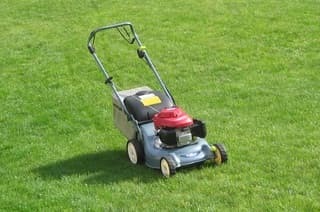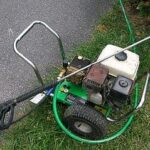As an Amazon Associate, this site earns commissions from qualifying purchases. For more information click here.
Lawn mower spark plugs should never leak oil. If it happens there is something wrong with the engine that requires your attention. There are many possible causes and this post will look at each one. By the end of this you will know what the causes are, how to fix it and how to prevent oil sparkplug leakage from happening again.
An oily lawn mower spark plug is most likely due to too much oil or a broken piston seal. Other possible causes are a flooded engine or ethanol induced overheating.
In these cases you have two choices, clean the spark plug and give it another try, or replace it with a new one. Bonfire you decide, let us take a look at each possible reason in detail so you can determine the best course of action.
Too Much Oil
This is the simplest explanation and also the most likely. If you put too much oil, the crankcase will overflow and oil will spill over onto the spark plug (among other parts).
If there is too much oil the mower will reek of it and you might see blue or white smoke when you run the mower. The engine might stall or fail. When any of these things happens, you know there is an oily spark plug causing it.
Solution. Lift the oil cap and tilt the mower so the excess oil coms out. Check the tank and add more oil if required. When you have the right amount of oil, put the cap back on. Clean the spark plug and turn on the mower. The
Solution. Lift the oil cap and tilt the mower so the excess oil coms out. Check the tank and add more oil if required. When you have the right amount of oil, put the cap back on. Clean the spark plug and turn on the mower. The Craftsman M105 makes this especially easy to do.
Damaged Piston Seal
The piston seal prevents oil from getting into the combustion chamber through a complex process. Due to wear and tear, mishandling, poor quality etc. the seal can crack or completely break. If this happens there is nothing to prevent the oil from leaking into the spark plug.
Because the piston ring plays an important role in the engine, you have to fix this problem as soon as possible. A leaky spark plug is just one possible result, as other issues can crop up if the oil spreads throughout your lawn mower.
Solution. A damaged piston seal needs to be looked into by a professional. Take the mower to a service center and have them examine it. In all likelihood this will require an engine rebuild. You should only try replacing or fixing the piston if you have the know-how. Otherwise this is best left to lawn mower service personnel.
Too Much Priming
One of the things you learn when using a lawn mower is that it needs to be primed first. In some cases however there could be too much priming. Overusing the choke will result in excess fuel going into the engine.
When the fuel overflows it spills everywhere including the spark plug. Even heat treated lawnmower blades cannot do much if the piston is not working.
Solution. Most lawn mowers only need to be primed three times. Yours might require more depending on the design. You should find this information on the owner’s manual or website. Follow the instructions given about priming.
Just like an overflowing fuel tank, this is an easy problem to fix. However if you primed it the right number of times and the mower won’t start, there is a problem with the other components, not an oily spark plug. This can be avoided with a high quality, easy to use machine. A good example of this is the PowerSmart Self Propelled Lawn Mower

Wrong Fuel Mix/Too Much Ethanol
Lawn mowers will only run on a specific mixture type of gas or fuel mix. If there is too much ethanol, the engine might not start at all. Even if it does, the mower will probably stop and leak oil everywhere. If you notice this, turn the lawn mower off right away and inspect the fuel tank.
Solution. Lawn mowers will only run if there is 10% or less ethanol in the fuel. If you think there is too much of it, empty the fuel tank. Pour new gas into the engine, making sure it has the right amount of ethanol in it.
To prevent this problem, consult your owner’s manual. Find the information about what fuel to use and the mixture required. Follow the guidelines and you should be able to avoid this issue.
Flooded Engine
An engine flooded with oil will cause all kinds of problems. For one it will make oil to spill over other components including the spark plug. Second it could get into the filter or damage other parts inside the lawn mower. This can be a serious problem that needs immediate attention.
Solution. Allow the lawn mower to idle for 15-20 minutes to drain the fuel. You can also take out the air filter to speed up the process. You may also remove the spark plug during this time.
Clean the spark plug and other oily parts. Once you have cleaned everything and let the mower idle, try running it again. This time it should work fine.
How to Clean or Replace an Oily Spark Plug
If the spark plug is old, you might as well replace it. But if it is new, it may be worth the effort to remove the oil. Once you have figured out the reason for the leak and fixed it, you can start cleaning the spark plug.
You will need:
- Clean rag
- Brake or carburetor cleaner
Instructions
Remove the spark plug. Apply cleaner on the plug and wipe it with the rag. Repast as often as necessary until the oil residue is gone.
How long this takes will depend on how much oil has leaked. You should also check the rest of the engine and see if oil has gotten anywhere else.
Do not forget to clean the spark plug port. The engine will stall or fail to start if there is oil around this area. Put a clean rag into the port and drive it as far as you can. Wipe as much of the excess oil as you can.
Apply starter fluid and wipe again. Put the spark plug back in and turn the mower on. Assuming the cause of the leak was fixed, your lawn mower should run fine now.
Spark Plug Needs Replacement
An old spark plug is prone to cracks, wear and tear. When oil gets all over it, the material gets harder and harder to clean. Even if you do manage to wipe the oil off, it probably will not function as well as it should.
In general, lawn mower spark plugs should be replaced after 25 hours of use or at the beginning of a new season, whichever comes first. This is only a general guideline however. If your spark plug is already showing signs of being worn out, replace it right away.
Other Ways to Fix an Oily Lawn Mower Spark Plug
The methods given above should work most of the time. But if they do not, there are other things you can try. Even if your mower is doing fine now, it is good Ida to have these supplies ready just in case the spark plug starts leaking oil.
Starter Fluid. Turn the choke off and remove the air filter. Apply the starter fluid on the carburetor. Clean the spark plug and other components covered with oil residue. Let them dry.
Turn on the lawn mower. If it starts, let the engine idle for a while so you can observe if it stalls. If the lawn mower is fine, you can put the other parts back.
Add Now Fuel. This one might be obvious for some, but it is worth noting. If the problem is related to fuel, pouring a new mix is often the best solution.
Lawn mower manufacturers provide instructions for fuel use. However mistakes do happen such as too using ethanol, too much oil or gas, contamination and so on. The fuel might also be too old. If it is more than 30 days in the tank, you should replace it.
Clean the Magnets and Coil. Set the valve to the off position and inspect for signs of corrosion. Brush off the dirt and clan the flywheel magnets too. You can do this while removing any oil covering the plug.
When you are finished, turn the lawn mower on again. It should start fine. Let it run for a while and then check the spark plug for any signs of oil leaks. If there is none, you are done cleaning and fixing.

I love the outdoors and all the tools for maintaining gardens, yards and lawns. The only thing I am more passionate about is sharing what I know about garden and outdoor equipment.


